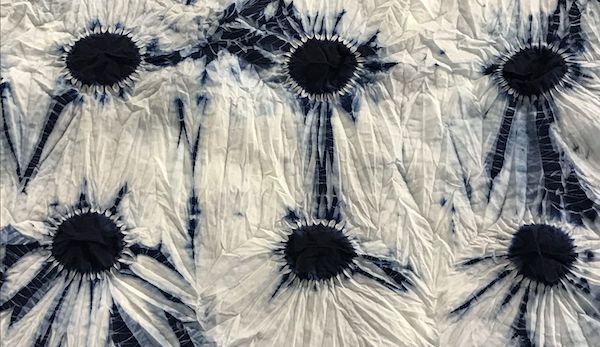
Tie And Dye

London-based Romor Designs was formed in the autumn of 2015 by Rob Jones, a shibori textiles designer and natural dyer. He discovered Japanese textiles while studying at West Dean College, then took a life-changing trip to Japan...
Studying textiles in Japan must have been quite the experience. What were the highlights?
I studied in Japan in 2014 with Bryan Whitehead, an amazing textiles artist, who has lived in Japan for over 30 years and has an encyclopedic knowledge of Japanese textiles crafts. Bryan lives in a picturesque mountain village called Fujino. The farmhouse is surrounded by forested mountains with some wonderful views and great walks. I particularly loved going to the workplace of one of Bryan's good friends, a master Katazome stencil dyer, and dyeing my humble designs in their indigo vats, nine feet deep set in the ground and watching the incredible skill and precision of him pasting part of a bolt of kimono cotton and matching the stencil perfectly every time.

How labour-intensive is shibori?
It depends very much on the design you are working on but, even simple repeated binding techniques can take hours to cover a piece of fabric. Then, if you do more complicated stitch work, it can take several days to complete a piece. When you've finished stitching a piece you have to pull all the threads up tightly and knot the end of every row securely. This has to be done meticulously or the dye will penetrate the wrong pieces of the design. Then the piece has to be dyed in the indigo. This is also a time-consuming process as colour is built up by repeated dips, each dip around 5 minutes duration and with a 15 minute oxidisation window afterwards. To get a dark colour can take 10-12 dips, an elapsed time of over 3 hours!

What is a typical work day like for you?
I tend not to get up too early (one of the perks of working for yourself), and doing some pilates/yoga followed by a mindful meditation to put me in the right mood for my day. If I'm not teaching I will usually spend the morning doing admin, emails, marketing and social media posts and then go off to my studio under an old railway arch in Hackney. Where does the name Romor Designs come from? I'd decided on Romor years ago, long before I ever had any kind of business! Its the "Ro" of my first name, Rob and the "mor" of my middle name, Morgan. It appealed because its a palindrome and, when I had my logo made a few years ago worked up into a really cool design that looks like a Hanko, which is the stamp that the Japanese use instead of a signature on important documents.

What is next for you and Romor Designs?
At the moment I'm experimenting with some vintage clothes - denim, corduroy, silks shirts, etc. I've also got a few craft fairs coming up, teaching in London and Exeter and then getting ready to teach the Shibori Summer School at West Dean for a week in August. Then I will be doing my final preparations to take my textiles group to Japan in November to work with Bryan.

2 comments
I love the Shibori technique and it is imperative to preserve and pass on traditional crafts (from around the world). Robert’s work is stunning and the lamps work beautifully, with such original and creative designs.
I too had the joyous experience of living in Japan. For three years. I learned the indigo dying process in Arimatsu and progressed from there. Being up to my arms in indigo vats, rinsing in mountain streams was paradise. I’ll never forget those days.